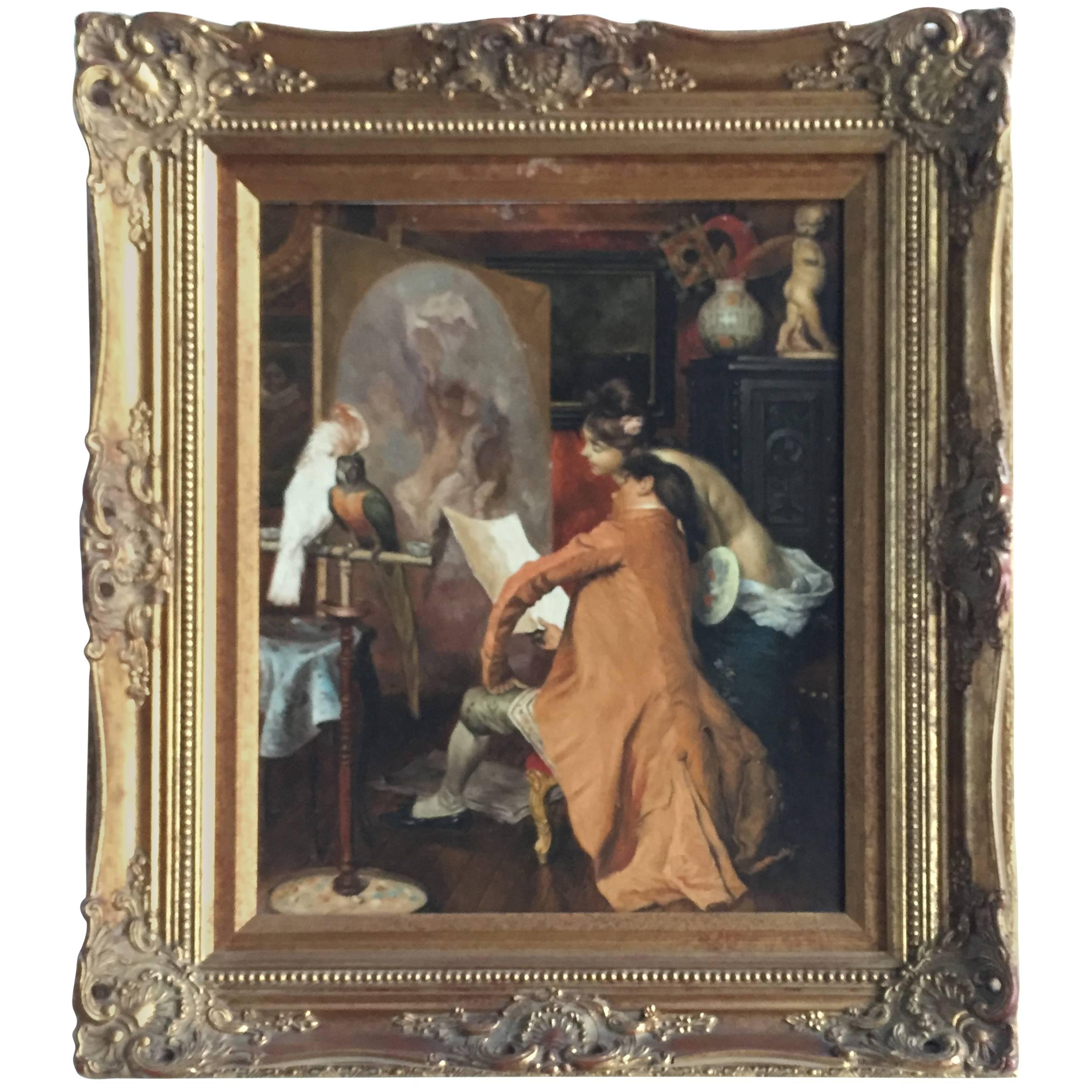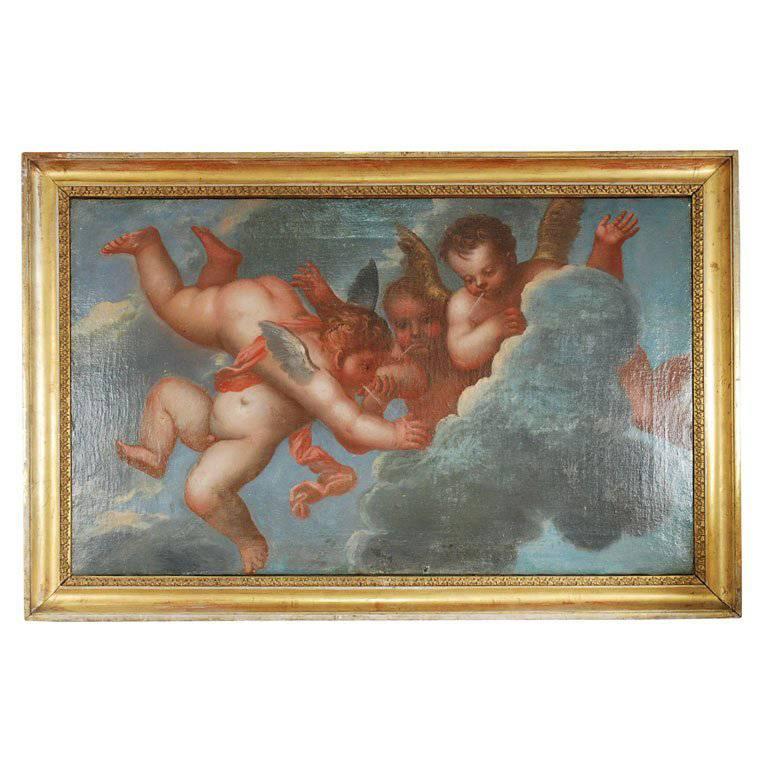Items Similar to 17th Century Rosa di Tivoli Painting on Slate
Want more images or videos?
Request additional images or videos from the seller
1 of 5
17th Century Rosa di Tivoli Painting on Slate
About the Item
A ram lowers its horns in a face off with a barking dog that rises on its haunches. An ox turns its head to watch the row. An annoyed ewe glances over its shoulder, but the two behind her don't deign to look. A pair of oblivious sheep graze at a distance to the right. Nothing could be more ordinary than a dog corralling a herd before heading home for the night. But what's extraordinary is the painter’s ability to portray an animal-kingdom drama. You might say the scene is the barnyard equivalent of a modern-day subway altercation, more posturing than fight, suggesting, intentionally or not, that the restive behavior of animals has much in common with that of humans.
The painter of this scene was Philipp Peter Roos, better known as Rosa di Tivoli. He was born in Germany to a family of painters who specialized in landscapes and animals. Early on, he worked in Frankfurt am Main under the protection of Charles I, Landgrave of Hesse-Kassel. Knowing talent when he saw it, that beneficent ruler sent the young Roos to Rome to perfect his art in 1677. There, his skill was honed in the studio of Giacinto Brandi. And in Rome he remained, after falling in love with his master’s daughter, Maria Isabella. In 1681, Roos, a Lutheran, converted to Catholicism to marry her. Three years later, they purchased a house in nearby Tivoli where they raised seven children. During those years his surname was Latinized to Rosa, and, following the change of address, he became known to the locals, and to posterity, as Rosa di Tivoli.
Tivoli is celebrated for a landscape of rolling hills garnished with ancient Roman ruins. Among them are the surviving arches of the famous aqueduct, which can be discerned, if just barely, through the evening gloom to the left in our painting. Rosa’s acreage in Tivoli allowed him to keep a menagerie of animals to serve as models, which is why his home was known as Noah’s Ark. Not that Rosa cut a figure of biblical propriety. He was one of many Northern painters then living in Rome who were notorious for carousing. He joined the Bentvueghels (Dutch for “birds of a feather”), a confraternity of German and Dutch painters who met in the Pantheon. That 2nd century temple, originally dedicated to all the pagan gods as its name would suggest, had since been rededicated to St. Mary and the Martyrs. The painters’ meetings there invariably turned into drinking binges, sending members hopscotching from tavern to tavern for weeks at a time. If many contemporary Romans looked down on the antics of these barbaric foreigners, aristocratic connoisseurs bestowed on them their patronage. This is why most of Rosa’s paintings are still to be found in the palazzi of the Colonna, Borghese, Ludovisi, and Doria Pamphilj families.
Connoisseurs were then partial to small jewel-like paintings on hardstones, which were selected for their suitability to the scene being depicted. For example, blue lapis lazuli was matched to scenes unfolding against a daytime sky, and black slate was matched to scenes unfolding against a nighttime sky. Our rustic scene, painted on slate, probably dates to the 1680s. In 1691, by which time dark Caravaggesque scenes like Rosa’s were no longer in vogue, so he had to sell Noah’s Ark, and return to Rome. He died there in poverty at the age of fifty-one. We know this from Arnold Houbraken, his contemporary, who included Rosa in the book he wrote on German and Dutch painters. There, he records: “In the year 1698-1699, the Landgrave of Hessen-Kassel, his first patron, came to Rome, and inquired after our Roos, whether he still lived, and after his conduct in life, and said, when he heard that he had changed his Religion, that I am still able to forgive him, but that he has never sent me a piece of his Art as proof of his gratitude I can never forget.”
- Creator:Philipp Peter Roos (Rosa di Tivoli) (Artist)
- Dimensions:Height: 8.25 in (20.96 cm)Width: 13.5 in (34.29 cm)Depth: 2 in (5.08 cm)
- Style:Baroque (Of the Period)
- Materials and Techniques:Slate,Painted
- Place of Origin:
- Period:1680-1689
- Date of Manufacture:circa 1685
- Condition:Replacements made: The upper right corner of the slate has been filled in and painted later. Wear consistent with age and use. The black-lacquered frame is later.
- Seller Location:New York, NY
- Reference Number:1stDibs: LU1061422880542
About the Seller
5.0
Recognized Seller
These prestigious sellers are industry leaders and represent the highest echelon for item quality and design.
Established in 1994
1stDibs seller since 2014
19 sales on 1stDibs
- ShippingRetrieving quote...Ships From: New York, NY
- Return PolicyThis item cannot be returned.
More From This SellerView All
- French 18th Century Trompe l'Oeil PaintingBy Piat Joseph Sauvage 1Located in New York, NYThis neoclassical trompe l'oeil painting is an allegory of summer. It would have been hung with allegories of the other three seasons over the doors of a salon. Ceres, Roman goddess...Category
Antique Late 18th Century French Neoclassical Paintings
MaterialsCanvas
- Small Painting by Jean Hugo from 1927By Jean HugoLocated in New York, NYGreat grandson of the famous writer Victor Hugo, the painter Jean Hugo (1894-1984) was in the thick of the Paris art scene between the wars. A member of the avant garde, he was a friend of Picasso, Cocteau and Colette and was associated with the Neo Romantics. His small gouaches on paper were avidly collected by Dr. Albert Barnes, and can be seen today in the Barnes Collection in Philadelphia. Hugo's most desirable work -- landscapes, interior scenes, set designs -- date from the mid 1920s to the late 1930s. This whimsical painting, signed and dated 1927, is set in a curtained, classical interior furnished with Victorian lighting fixtures...Category
Vintage 1920s French Romantic Paintings
MaterialsGouache
- Mughal Indian MiniatureLocated in New York, NYThis Mughal miniature was painted at one of the princely courts of India. It depicts a raven-haired princess in a gold-trimmed saffron-colored silk sari. Under a glowering evening sky she dawdles on a white marble terrace, with a pet fawn on a leash, before a landscape dotted with buildings nestled amongst trees beyond a river. Her hair, falling loosely about her shoulders, rather than carefully dressed on her head, indicates that she is a maiden. The overall mood is one of expectancy. Perhaps walking a pet and catching an evening breeze is a pretext to escape palace scrutiny for a lovers’ assignation. In Mughal India tender sentiments were a bridge to the erotic – and if this seems contradictory, so too is the balance of realism and caricature, and naturalism with the schematic. Both are hallmarks of miniatures painted in this place and time. The earliest Mughal Indian miniatures date to the 16th century. They were inspired by those painted at the refined Moslem courts of the neighboring Persian empire. They incorporated figures in spite of the Moslem faith’s proscription against depicting the human form. Such was the nature of sophisticated courtly life everywhere that beauty and pleasure trumped systems of morality. This was no less the case at the provincial Indian courts, where our miniature, marked by a charming pictorial naiveté, was most likely painted. Yet the artist was undeniably accomplished. His command of perspective, introduced by Jesuit missionaries in the 17th century, is seen in the landscape, which rolls back to a distant horizon, contrary to the flat two-dimensional ones following Indian-painting traditions. And if Mughal artists were influenced by Western art, the compliment was returned by Rembrandt and Sir Joshua Reynolds, among others, who collected Indian miniatures (as did, perhaps, Giovanni Bellini who painted in Mughal style the famous miniature of a Persian man...Category
Antique 18th Century Indian Anglo-Indian Paintings
MaterialsPaper
- 19th Century French Table on Wheels with a Modern Black-Glass TopLocated in New York, NYThis charming, quirky 19th century black-painted cast-iron table is mounted on wheels, and fitted with a modern custom black opaline-glass top framed in bronze by Guerin.Category
Antique 1870s French Napoleon III Tables
MaterialsBrass, Iron
- 19th Century Chinese ScreenLocated in New York, NYThis Chinese standing screen has a main panel, and a lower panel flanked by two smaller ones, which were made in the 19th century as fretwork window panels for a house. In the 20th century they were salvaged, assembled, and mounted in a matching hardwood stand as a freestanding screen...Category
Antique Late 19th Century Chinese Qing Furniture
MaterialsHardwood
- Italian, 18th Century Decorative PanelBy BonzanigoLocated in New York, NYA neoclassical painted and gilded overdoor panel in the manner of Giuseppe Maria Bonzanigo, circa 1790.Category
Antique 1790s Italian Neoclassical Decorative Art
MaterialsWood
You May Also Like
- 17th Century PaintingLocated in Miami, FL17th century painting J.Castano 17th century SpainCategory
Antique 17th Century Baroque Paintings
MaterialsCanvas
- Pastoral scene, oil on canvas, by P. P. Roos dit Rosa Da Tivoli Italy circa 1680By Philipp Peter Roos (Rosa di Tivoli)Located in Paris, FRLarge oil on canvas depicting farm animals (sheeps, goat, horse, dog) at the watering trough, against a backdrop of a Roman countryside landscape. Philipp Peter Roos was a German pa...Category
Antique Late 17th Century Italian Baroque Paintings
MaterialsCanvas, Paint
- 17th Century Oil on Board PaintingLocated in Atlanta, GAA very beautiful early 17th century oil on board painting of Saint Eugene - The Archbishop Of Toledo, Spain. Wonderful brushwork and intricate detail....Category
Antique Early 17th Century French Paintings
MaterialsWood
- 17th-18th Century Venetian PaintingLocated in Pembroke, MAVenetian School painting of four angels, allegorically depicting the variable winds of change and time. Unsigned, believed to be by a follower of Pietro Li...Category
Antique 17th Century Italian Baroque Paintings
MaterialsGiltwood, Canvas
- Spanish 17th Century Oil on Copper PaintingLocated in Atlanta, GAA wonderful 17th century oil on copper painting from the Catalan region of Spain housed in a beautiful frame of painted wood. The painting depicts a saint or a religious man...Category
Antique 17th Century Spanish Paintings
MaterialsCopper
- Kitchen interior, oil painting on canvas, northern Italy, 17th centuryLocated in Brescia, ITKitchen interior, oil painting on canvas, northern Italy, 17th century Two characters, still life with rich game and vegetables, tableware, a dog and a cat. Northern Italy, 17th ...Category
Antique 1680s Italian Baroque Paintings
MaterialsCanvas, Wood





